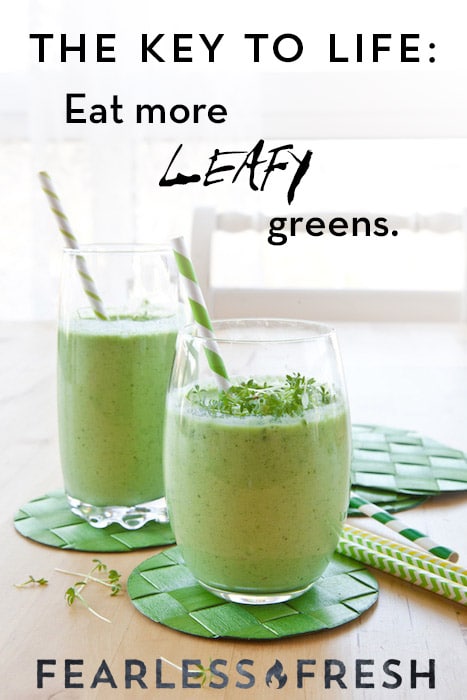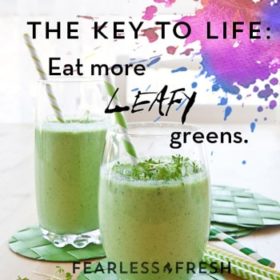Leafy Greens You Need in Your Life (and Easy Ways to Incorporate Them)

Ok, because you're interested in living longer than the guinea pig you had as a kid, it's time for a moment of truth: Do you eat leafy greens every day?
At least a little bit?
Or none at all?
Maybe you buy vegetables when you go grocery shopping, totally intending to use them up when deciding what to cook for dinner tonight, but end up with a science experiment of yellow, month-old kale and mushy celery hiding in your crisper drawer?
No worries, I'm not here to judge. I know firsthand that it's tough to get enough leafy greens in your diet, and I have to work very hard to change that in my own life. The truth is simple, though. The more greens I eat the better I feel, and as I get older, I'm realizing that being lazy and catering to my pickiness aren't good enough reasons to feel like crap in my body. I want to feel good, and that's going to take a little work – starting with making some home cooked meals, and incorporating more greens into my diet.
And that whole habit of filling my grocery basket with veggies only to have them rot in my fridge really, really sucks. The thing is, when you eat more leafy greens, healthy eating isn't that difficult because you're getting the bulk of your nutrients in short order. Plus leafy greens are usually a lot cheaper then other produce, which is handy.
For ages doctors and dietitians have been spouting off about how we need to eat more vegetables, and at the top of that "must eat" list are dark leafy greens. Problem is, they're not exactly at the top of most Americans' lists when it comes to ideas for dinner. Many greens, like chard and kale, are not exactly what a lot of folks would call their favorite foods – and not liking something sure makes it difficult to eat more if it, doesn't it?
Greens are one of the most healthy foods to eat. Hands down.
While opinions of how many greens you should eat varies from study to study and doctor to doctor, one thing's for sure: most people do not eat enough fresh greenery on a daily basis. And contrary to popular belief, eating only cooked greens isn't going to cut it. You need to eatraw greens as well.
Yes, I heard the FEH! that just floated through your mind.
Many folks have a difficult time digesting raw greens because it's not something we do regularly. Our delicate 21st-century jaws are used to eating mostly soft foods and therefore aren't strong enough to really chew up roughage into a consistency our digestive systems can easily break down. Anthropologists have found that our ancestors were able to do this easily, because they ate raw greens all the time. Their jaws were in better shape because they got the Hunter Gatherer Workout™ throughout the day.
To compound the problem, most folks eat too fast. In order to really break down tougher leaves and mix them with the enzymes in our saliva (which is where digestion begins) we need to slow down and chew for a good, long time. Due to all of the cooked foods we consume, our jaws are not nearly as strong as those of our distant ancestors. Hell, even when you make it a point to chew and chew and chew your greens to a creamy consistency, it's a fairly difficult thing to do.
The result is that when we eat raw leafy greens, we're not able to chew them down enough to play nicely with our digestive systems. The unbroken, fibrous material essentially causes your gut to say, "Wha….?" Which then causes your gut to cramp up and hit the fast-foward button. Ugh.
Learning to cook and eat more greens is important, but they need to actually stay in your digestive tract long enough for you to absorb their nutrients to be of any value. Greens don't serve their purpose when they come flying out at warp speed.
Want to live longer? Enter green smoothies.
Years ago I picked up a copy of Victoria Boutenko's Green for Life, in the hopes that I would somehow manage to incorporate a green smoothie into my morning ritual. For those not in the know, a green smoothie is basically a fruit smoothie with a handful of dark leafy greens thrown in. Blending greens breaks everything down into a consistency that your body is more easily able to digest.
And you don't need a $400 high speed blender to pull this off – the little Oster someone gave you at your wedding will work just fine, if you let it blend for a full sixty seconds.
The added bonus is that green smoothies make fast work of all those vegetables in your refrigerator that would normally end up congealing into a flaccid, fuzzy puddle because you either forgot to eat them or didn't have time to cook.
Now, I totally get that the thought of throwing some kale into your blender with an apple and a banana might make you shudder, but I've got to tell you that honestly, it's not awful. I promise. In fact, if done correctly, it's damn good! A green smoothie is a tasty way to help get your daily dose of greens.
Plus, it doesn't take much to make you feel good.Just one tiny quart of green smoothie a day will improve your health.
Healthy eating isn't so hard, and as with anything else, there's a right and wrong way to do it. There's also a right and wrong way to make a green smoothie. Start simple and follow tried and true mixtures, like the one below. You will learn what you like (spinach and apples) and what you don't like (brussel sprouts and strawberries). Once you've got the hang of it, not only will you become more adventurous with your smoothies, but you'll also feel more energetic and alert. As you get used to the idea of blended veggies, up the amount of roughage you add to your smoothies to get as many leafy greens into your body as you can.
If you're going to make one single change to eat real food daily, this is the easiest, most important step you can take.
Keep this in mind when you begin: don't jump into challenging greens like dino kale.Start with milder greens like spinach, romaine, or the spring greens bag they sell at your local grocery s. And obviously, stronger tasting fruits such as pineapple will balance out stronger tasting greenery. The recipe I've listed below is very sweet and honestly, there's only a hint of "green taste." Not too shabby!

- 2 whole frozen bananas
- 1 whole peach cut into slices and frozen
- 1/2 mango cut into cubes and frozen
- 1 large handful baby spinach (about 1/2 cup)
-
Blend until smooth, but not so long that it heats up. If you're feeling adventurous, add four or five basil leaves. It's actually a pleasant compliment to the peach and mango.
-
Note: be sure to freeze your fruit first as it will result in a nice, frosty shake. Many health food stores and organic co-ops now stock frozen organic fruit in the freezer section, which is great to have on hand in a pinch.
Calories: 165 kcal | Carbohydrates: 42 g | Protein: 2 g | Fat: 1 g | Sodium: 8 mg | Potassium: 686 mg | Fiber: 5 g | Vitamin A: 2900 IU | Vitamin C: 42.1 mg | Calcium: 20 mg | Iron: 0.7 mg
This content was originally posted on FearlessFresh.com.
Source: https://fearlessfresh.com/key-to-life-greens/